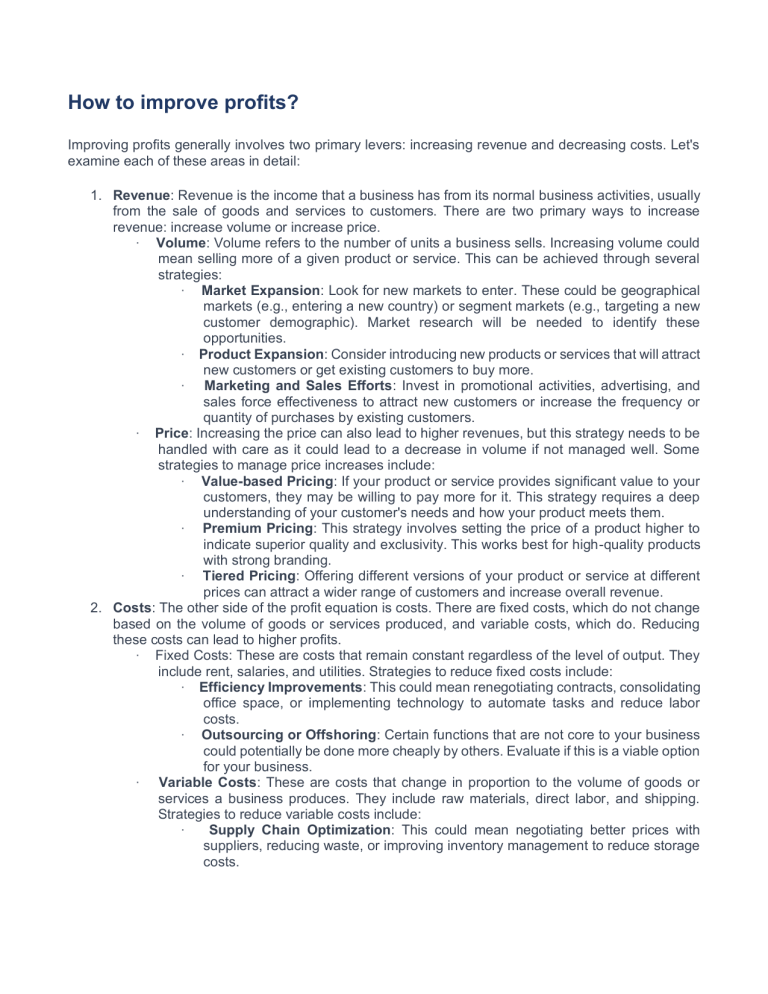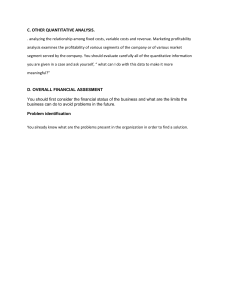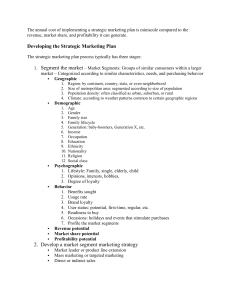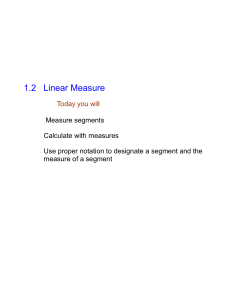
How to improve profits? Improving profits generally involves two primary levers: increasing revenue and decreasing costs. Let's examine each of these areas in detail: 1. Revenue: Revenue is the income that a business has from its normal business activities, usually from the sale of goods and services to customers. There are two primary ways to increase revenue: increase volume or increase price. · Volume: Volume refers to the number of units a business sells. Increasing volume could mean selling more of a given product or service. This can be achieved through several strategies: · Market Expansion: Look for new markets to enter. These could be geographical markets (e.g., entering a new country) or segment markets (e.g., targeting a new customer demographic). Market research will be needed to identify these opportunities. · Product Expansion: Consider introducing new products or services that will attract new customers or get existing customers to buy more. · Marketing and Sales Efforts: Invest in promotional activities, advertising, and sales force effectiveness to attract new customers or increase the frequency or quantity of purchases by existing customers. · Price: Increasing the price can also lead to higher revenues, but this strategy needs to be handled with care as it could lead to a decrease in volume if not managed well. Some strategies to manage price increases include: · Value-based Pricing: If your product or service provides significant value to your customers, they may be willing to pay more for it. This strategy requires a deep understanding of your customer's needs and how your product meets them. · Premium Pricing: This strategy involves setting the price of a product higher to indicate superior quality and exclusivity. This works best for high-quality products with strong branding. · Tiered Pricing: Offering different versions of your product or service at different prices can attract a wider range of customers and increase overall revenue. 2. Costs: The other side of the profit equation is costs. There are fixed costs, which do not change based on the volume of goods or services produced, and variable costs, which do. Reducing these costs can lead to higher profits. · Fixed Costs: These are costs that remain constant regardless of the level of output. They include rent, salaries, and utilities. Strategies to reduce fixed costs include: · Efficiency Improvements: This could mean renegotiating contracts, consolidating office space, or implementing technology to automate tasks and reduce labor costs. · Outsourcing or Offshoring: Certain functions that are not core to your business could potentially be done more cheaply by others. Evaluate if this is a viable option for your business. · Variable Costs: These are costs that change in proportion to the volume of goods or services a business produces. They include raw materials, direct labor, and shipping. Strategies to reduce variable costs include: · Supply Chain Optimization: This could mean negotiating better prices with suppliers, reducing waste, or improving inventory management to reduce storage costs. · · Economies of Scale: If you can increase the volume of output, the cost per unit may decrease. This could be due to spreading out fixed costs, operational efficiencies, or volume discounts from suppliers. Process Improvement: Implementing lean manufacturing or other process improvement methodologies can help to reduce waste and inefficiency, thereby reducing costs. How to grow the business? Growing a business involves expanding the current operations or venturing into new areas. Here are strategies for each: 1. Grow the Core Business: This involves strengthening and expanding the existing business operations. This can be achieved in two ways: · Growth Within Current Segments: Here, the focus is on gaining more customers or selling more to existing customers within your current market segments. Some strategies to achieve this could include: · Customer Retention: Invest in customer service and relationship management to keep your current customers satisfied and loyal. This could involve developing a customer loyalty program or improving after-sales support. · Customer Acquisition: Strengthen your sales and marketing efforts to attract new customers within your existing market segments. This could involve improving your advertising, enhancing your sales force, or using digital marketing techniques to reach a wider audience. · Upselling and Cross-Selling: These strategies involve selling more to your existing customers, either by selling them a higher-priced product (upselling) or by selling them related products (cross-selling). · Focus on Fastest-Growing Segments: Identify the segments within your current market that are experiencing the most growth, and focus your resources on these areas. This could involve conducting market research to identify these growing segments and developing products, services, or marketing strategies that are tailored to these segments. 2. Grow Outside of the Core Business: This involves expanding beyond your current operations, either by selling new products or entering new businesses. Some strategies for this could include: · Sell New Products: One way to grow is by expanding your product offerings. This could involve developing new products that are related to your existing products, or it could involve diversifying into entirely new product areas. This strategy could also involve introducing your existing products into new markets. · Product Development: This involves creating new products that meet emerging customer needs or that offer better performance or more features than your current products. · Product Diversification: This involves developing entirely new products that are unrelated to your current products. This strategy can help to spread risk, but it also requires significant resources and expertise. · Use Our Capabilities to Get into New Businesses: If your company has capabilities that are transferrable to other industries, you could consider leveraging these capabilities to enter new businesses. This could involve: · Vertical Integration: This involves taking on a function that was previously performed by a supplier (backward integration) or by a customer (forward integration). For example, a clothing retailer might start manufacturing its own clothes (backward integration), or a manufacturer might start selling directly to consumers (forward integration). · Horizontal Integration: This involves expanding into new businesses that are at the same level of the value chain but in a different industry. For example, a company that manufactures car parts might start manufacturing parts for airplanes. · Diversification: This involves entering entirely new businesses that are unrelated to the current business. This strategy can help to spread risk, but it also requires significant resources and expertise. How to reduce costs? Cost reduction is crucial for improving a company's profitability and ensuring its financial health. Here's a detailed look at the options you listed: 1. Reduce the Need/Source: This involves identifying areas where spending can be reduced or eliminated. This could be achieved through two methods: · Eliminate the Need Entirely: This approach involves identifying areas of the business that are not contributing to its profitability or strategic goals and eliminating them. This can be a tough decision, especially if it involves eliminating a product, service, or even a department. However, if these areas are not contributing positively to the company's bottom line, eliminating them could lead to significant cost savings. · Reduce the Service Level: This involves providing a lower level of service in certain areas to reduce costs. This could involve reducing the hours of operation, offering fewer features, or using less expensive materials. However, this strategy must be implemented carefully to avoid negatively impacting customer satisfaction. It's crucial to communicate any changes clearly and honestly with customers, and to reassure them that the quality of the products or services they receive will not be compromised. 2. Meet the Need with Less Resources: This involves finding ways to deliver the same level of products or services using fewer resources. This could be achieved in two ways: · Eliminate Waste: This involves identifying and eliminating activities that do not add value to the product or service. This could be achieved through lean manufacturing or similar methodologies, which focus on reducing waste in all its forms, including overproduction, waiting time, transportation, over-processing, inventory, motion, and defects. Implementing a continuous improvement process can help to identify and eliminate waste on an ongoing basis. · Improve Productivity: This involves finding ways to get more output from the same amount of input. This could involve improving processes, investing in technology, or training employees to work more efficiently. Implementing productivity improvement techniques such as Six Sigma or Total Quality Management can help to improve productivity by reducing variation and defects in processes. Whether to enter a new market? Entering a new market is a major strategic decision, and it requires careful analysis of various factors. Let's examine each of these areas in detail: 1. Market Opportunity: The first step in evaluating whether to enter a new market is to assess the opportunity that the market presents. · Market Size: This refers to the total potential sales of a product or service in a particular market. The larger the market size, the greater the potential for sales. However, larger markets also often have more competition. Market size can be assessed through market research, industry reports, and other data sources. · Market Growth: This refers to the rate at which the market is growing. A rapidly growing market presents a greater opportunity for a new entrant, as it suggests increasing demand for the product or service. Market growth can be assessed through historical data and future projections. 2. Potential Share: The next step is to assess the potential market share that your company could capture. · Competitors: Understanding the competitive landscape is crucial. This includes knowing who the major players are, their strengths and weaknesses, their strategies, and their market shares. This will help you understand the barriers to entry and how your company can differentiate itself. · Customer Needs: Understanding the needs, preferences, and behaviors of customers in the market is crucial. This involves conducting market research to understand what customers value and how well their needs are currently being met. · Our Offering: The product or service that your company plans to offer in the new market must be competitive. This involves assessing the features, benefits, and pricing of your offering relative to competitors. 3. Potential Profit: The next step is to evaluate the potential profitability of entering the new market. · Investment: Entering a new market often requires a significant upfront investment. This could include costs related to market research, product development, marketing, distribution, and more. · Running Costs: This includes the ongoing costs of operating in the market, such as production costs, marketing costs, and operating expenses. · Revenue: This involves estimating the potential revenue that your company could generate in the new market. This should be based on your assessment of market size, market growth, and potential market share. 4. Capabilities and Risks: Finally, it's important to consider your company's capabilities and the risks involved in entering the new market. · Capabilities: Does your company have the resources, skills, and capabilities to compete effectively in the new market? This could include financial resources, technological capabilities, human resources, and more. · Risks: Entering a new market is inherently risky. This could include market risks (such as demand fluctuations or regulatory changes), competitive risks (such as a strong response from competitors), operational risks (such as difficulties in managing a new operation), and financial risks (such as not achieving the expected return on investment). How to launch a new product? Launching a new product is a significant undertaking and involves several key steps. Here's a detailed look at your outlined approach: 1. Choose Target Segments: Before you launch a new product, it's essential to identify who your target customers are. This involves segmenting the market and choosing the segments that offer the best opportunity. · Size & Growth: Larger and/or faster-growing segments offer more potential customers and therefore a greater opportunity. Market research and industry reports can provide data on segment size and growth rates. · Competition: Some segments may already be saturated with competitors, making it harder for a new product to gain a foothold. Analyzing the competitive landscape can help you understand the opportunities and challenges in different segments. · Customer Needs: Understanding the needs and preferences of customers in each segment is crucial. This will help you tailor your product and marketing strategy to meet these needs. 2. Define Our Strategy: Once you've chosen your target segments, the next step is to define your go-to-market strategy. · Product: What features and benefits will your product offer? How does it meet the needs of your target customers? How does it compare to competing products? · Price: How will you price your product? This should reflect the value that your product offers, as well as factors like production costs and what the market will bear. · Distribution: How will you get your product into the hands of customers? This could involve choosing retailers, setting up an online store, or using a direct sales force, among other options. · Brand and Advertising: How will you build awareness and preference for your product? This involves creating a brand identity that resonates with your target customers, and implementing an advertising strategy that effectively communicates your product's features and benefits. 3. Implementation: Once your strategy is defined, the next step is to implement it. This involves: · Product Development: This involves finalizing the design and production of your product. You may need to source materials, set up production processes, and ensure quality control. · Marketing and Sales Execution: This involves executing your distribution, branding, and advertising strategies. It could involve training sales staff, launching an advertising campaign, and monitoring and adjusting your strategies as necessary. · Customer Service: Providing excellent customer service is crucial for the success of your product. This could involve setting up a customer service department, training staff, and setting up systems to handle customer inquiries and complaints. How to price a new product? Pricing a new product is a critical decision that can significantly impact its success in the market. Here's a detailed look at your outlined approach: 1. Costs: The cost of producing and selling the product sets a floor for your pricing. You need to cover these costs to make a profit. · Variable Costs: These are costs that change in direct proportion to the volume of units produced, such as raw materials and labor costs. You must ensure that the price of your product covers these costs, or you will lose money on each unit sold. · Investment Costs: These include the upfront costs to develop and launch the product, such as research and development, marketing, and distribution setup costs. These costs are typically spread out over the expected sales volume over a certain period (e.g., the product's lifecycle), contributing to the necessary price per unit. · Fixed Costs: These are costs that do not change with the volume of units produced, such as rent, salaries, and utilities. Like investment costs, these costs are typically spread out over the expected sales volume to determine the minimum price per unit. 2. Clients' Willingness to Pay: The value that customers perceive in your product sets a ceiling for your pricing. If the price exceeds what customers are willing to pay, sales will be low. · Market research can help you understand how much customers value your product and what they would be willing to pay for it. This could involve surveys, focus groups, or conjoint analysis, among other methods. · The perceived value of your product could be based on a variety of factors, including its features and benefits, the problems it solves, how it compares to competing products, and the strength of your brand. 3. Competitors or Substitutes: The prices of competing or substitute products can influence the acceptable price range for your product. · If your product is similar to existing products, customers will likely expect the price to be in the same ballpark. You may be able to charge a premium if your product offers significant advantages or if your brand is particularly strong. · If there are substitute products available (i.e., different products that can meet the same need), their prices will also influence customers' willingness to pay for your product. Whether to acquire a new business? Deciding whether to acquire a new business is a significant strategic decision that involves careful consideration of various factors. Here's a detailed look at your outlined approach: 1. Standalone Value: The first step is to evaluate the standalone value of the potential acquisition. This means assessing the value of the business as it currently operates, independent of any synergies with your existing operations. · Future Revenue: This involves estimating the future revenue that the business is expected to generate. This should be based on the company's historical performance, its growth prospects, and trends in its industry and markets. · Future Cost: This involves estimating the future costs of running the business. This should include all operating costs, such as cost of goods sold, selling and administrative expenses, and capital expenditures. · Valuation Multiples: Valuation multiples can provide a benchmark for assessing the value of the business. This could include multiples based on earnings (like P/E or EV/EBITDA) or revenues (like Price/Sales), among others. Comparing these multiples with those of similar companies can provide a sense of whether the business is fairly valued. 2. Synergies: The next step is to assess the potential synergies between the business you're considering acquiring and your existing operations. Synergies can create additional value beyond the standalone value of the two businesses. · Revenue Growth: Synergies could lead to increased revenue. This could be achieved through cross-selling, accessing new markets, or leveraging stronger brand recognition, among other strategies. · Cost Reduction: Synergies could also lead to reduced costs. This could be achieved through economies of scale, eliminating duplicate functions, or leveraging shared technologies or resources, among other strategies. 3. Capabilities and Risks: Finally, it's important to assess your company's capabilities to integrate the new business and manage the associated risks. · Capabilities: Does your company have the skills, resources, and experience to successfully integrate the new business? This could involve managing cultural differences, integrating systems and processes, and retaining key employees, among other challenges. · Risks: Acquisitions involve significant risks. This could include financial risks (like overpaying for the acquisition or not achieving the expected return on investment), operational risks (like difficulties in integrating the new business), and strategic risks (like diverting focus from your core business). Whether to make an investment? Deciding whether to make an investment is a significant decision that can have long-term impacts on your business. Here's a detailed look at your outlined approach: 1. Impact on Costs: The first step is to understand how the investment will impact your costs. · Initial Investment Cost: This includes the upfront cost of making the investment. This could be the price of a piece of machinery, the cost of developing a new product, or the amount required to acquire another business, among other possibilities. · Ongoing Costs: This includes any additional costs that will be incurred as a result of the investment. For instance, new equipment might increase your energy usage, a new product might require additional marketing spending, or an acquired business might have operational expenses that need to be maintained. · Cost Savings: On the flip side, the investment might lead to cost savings in the long run. For example, a more efficient machine might reduce labor costs, or a new software system might streamline operations and reduce administrative expenses. 2. Impact on Revenue: The next step is to estimate how the investment will impact your revenue. · Increased Sales: The investment might lead to increased sales. For example, a new product could attract new customers, an expanded production capacity might allow you to meet greater demand, or an acquired business might bring in additional revenue streams. · Pricing Power: The investment might also enable you to charge higher prices. For instance, a product with improved features might justify a price increase, or an investment in branding might increase customers' willingness to pay. 3. Implementation: Finally, it's important to consider the feasibility and risks associated with implementing the investment. · Feasibility: Do you have the resources and capabilities to implement the investment successfully? This might involve technical expertise, management capacity, or financial resources, among other factors. · Risks: All investments involve risks. These could include operational risks (like technical difficulties or delays), financial risks (like cost overruns or lower-than-expected returns), and strategic risks (like changes in market conditions or competitive responses). How to respond to a competitive threat? Responding to a competitive threat requires a strategic approach that assesses the potential impact, understands the competitor's opportunity, and determines the most effective response. Here's a detailed look at your outlined approach: 1. Potential Impact on Our Business: The first step is to assess the potential impact of the competitive threat on your business. · Segment Affected: Which segment of your business is under threat? Is it a core part of your business or a peripheral one? The importance of the threatened segment will influence the urgency and scale of your response. · Estimated Loss: What is the potential loss if the competitive threat materializes? This could include lost revenue, decreased market share, or damage to your brand. Quantifying the potential loss will help prioritize your response. 2. Opportunity Pursued by Competitor: The next step is to understand the opportunity that the competitor is pursuing. · Size: How big is the opportunity that the competitor is targeting? If it's a large opportunity, it might be more likely to draw resources and focus from the competitor, making the threat more significant. · Profitability: How profitable is the opportunity? If it's highly profitable, the competitor might be more motivated to succeed, making the threat more significant. 3. Possible Responses: Finally, it's important to consider your possible responses to the competitive threat. · Do Nothing: If the threat is minor or unlikely to materialize, it may be best to do nothing and continue with your current strategy. · Mitigate: This could involve actions to reduce the potential impact of the threat. This could include improving your product, adjusting your pricing, or enhancing your marketing efforts. · Align: This could involve aligning your strategy with the competitor's. For example, if the competitor is pursuing a new market segment, you might also decide to target that segment. · Replicate: This involves replicating the competitor's strategy. For example, if the competitor has launched a new product, you might decide to launch a similar product. · Collaborate: In some cases, it might be beneficial to collaborate with the competitor. This could involve a partnership, a joint venture, or even a merger. How to optimize a process? Optimizing a process involves making changes that allow it to achieve a desired outcome more efficiently or effectively. Here's a detailed look at your outlined approach: 1. Map Out Current Process: Before you can improve a process, you need to understand it thoroughly. This involves mapping out the current process in detail. · Capacity: What is the maximum output that the process can produce in a given period? This could be influenced by factors such as the number of resources, the efficiency of equipment, and the complexity of tasks. · Utilization: How much of the process's capacity is currently being used? If utilization is low, there may be opportunities to increase output without increasing capacity. · Bottlenecks: Where are the points in the process where work accumulates because it arrives too quickly to be handled? Identifying and addressing bottlenecks can significantly improve the efficiency of a process. 2. Look Into Each Step of the Process: Once you've mapped out the current process, the next step is to look at each step in detail and identify opportunities for improvement. · Eliminate: Are there steps in the process that don't add value and could be eliminated? This could include unnecessary approvals, redundant checks, or activities that don't contribute to the desired outcome. · Reduce Cost: Are there steps in the process where costs could be reduced? This could involve using fewer resources, negotiating better prices with suppliers, or finding more efficient ways to perform activities. · Increase Speed: Are there steps in the process that could be done faster? This could involve improving skills, using better tools or equipment, or redesigning the way the activity is performed. · Increase Quality: Are there steps in the process where the quality could be improved? This could involve improving training, implementing better quality control measures, or using higher quality inputs. · Anticipate: Are there steps in the process where problems frequently occur? Anticipating these problems and implementing preventive measures can improve the efficiency and reliability of the process. 3. Estimate Gains: Finally, it's important to estimate the potential gains from process optimization. This involves quantifying the expected improvements in terms of increased output, reduced costs, faster turnaround times, or improved quality. Porter’s Five Forces In business, demand for products or services comes from customers. Their needs and preferences drive their purchasing decisions, and their willingness to pay influences the price that businesses can charge. Understanding customers is therefore crucial for any business strategy. To fully understand the competitive environment in which a business operates, one can use Porter's Five Forces framework. This model, developed by Harvard Business School professor Michael E. Porter, analyzes the competitive forces within the industry environment. The five forces are: 1. Threat of New Entrants: New entrants increase competition in the industry, potentially eroding profitability. Barriers to entry, such as capital requirements, regulations, brand loyalty, and access to distribution channels, can affect this threat. 2. Bargaining Power of Suppliers: When suppliers have strong bargaining power, they can demand higher prices or better terms, which can reduce industry profitability. Factors like supplier concentration, uniqueness of supplier's products, and switching costs affect supplier power. 3. Bargaining Power of Buyers: Similarly, when buyers (customers) have strong bargaining power, they can demand lower prices or better quality, which can also reduce profitability. Buyer concentration, availability of substitutes, and price sensitivity can affect buyer power. 4. Threat of Substitute Products or Services: When there are viable substitutes for a product or service, it can put a cap on the price that businesses can charge, affecting profitability. The availability, relative price, and perceived quality of substitutes influence this threat. 5. Rivalry Among Existing Competitors: High levels of rivalry can lead to price wars or increased spending on marketing or R&D, reducing profitability. Factors influencing this rivalry include industry growth rate, product differentiation, and exit barriers. In a consulting case, Porter's Five Forces analysis is essential because it provides a structured way to analyze the industry structure and competitive forces. It helps in understanding how each force affects the profitability of the industry and thus the attractiveness of the business or strategy in question. It allows the consultant to not only identify the sources of current competitive pressure but also anticipate future changes, forming a solid foundation for strategic planning and decision-making. Anna’s Call - Notes Focused on advising the leaders of the world’s top organizations on how to approach their biggest challenges and opportunities. Typical activities might include analyzing data, creating presentations or dashboards for clients, participating in problem-solving sessions and conducting interviews. Case interview Format Brief: The interviewer gives a brief for the case. They explain the context the organization in the case is operating in and the challenges that they’re facing. Clarification: The candidate then has a chance to ask clarifying questions, perhaps to test or confirm an understanding of the context or of the problem itself. Reflection: The candidate takes around 30 seconds to reflect and lay out a structured approach to solving the case. Analysis: The interviewer and the candidate work through the case together, carrying out analyses and ultimately driving towards a recommendation. This is the part of the case where the candidate will be handling numerical questions, reviewing exhibits, and coming up with creative ideas. It comprises the majority of the time spent on the case. Synthesis: The candidate synthesizes their findings and makes an overall recommendation. Terms to research and expand: Standalone value of a firm, synergies, capabilities to execute the acquisition, Notes from the FLASHFASH video: Take notes during the introduction to the case, (e.g. 25bn dollars revenue, note it down, all numbers, all details relevant for CALCULUS and STRATEGY) Ask clarifying questions during the introduction, show business leadership in solving and understanding the case. Then recap the question, maybe ask WHY they want to do a certain thing (e.g. acquisition of a business, as acquisition could be a faster way to drive growth with respect to their traditional model). Is it a binary decision (yes or no) or are there any other solutions which may be considered? ________________ Take your time to structure the beginning of the analysis and recap everything, then make the first step which you would like to know more about. Divide the analysis of the aspects to be clarified according to MECE (eah categorization must be mutually exclusive)





